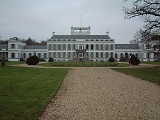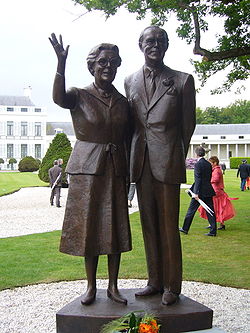
Soestdijk Palace
Encyclopedia
Soestdijk Palace is a former palace
of the Dutch royal family
. It consists of a central block and two wings.
Although named after the village of Soestdijk
, which is largely in the municipality of Soest
, the Soestdijk Palace is just north of the border in the municipality of Baarn
in the province of Utrecht
. It was the home for over six decades of the late Queen Juliana
and her husband, the late Prince Bernhard until their deaths in 2004.
. After the rampjaar
his son Jacob de Graeff
sold it to Stadhouder William III
. Then the palace originally started as a hunting lodge that was built between 1674 and 1678 by Maurits Post
, who was also involved in building two other royal palaces, Huis ten Bosch Palace and Noordeinde Palace
. William left the Netherlands in 1688 to reside in London as William III of England.
During the french invasion in 1795, the palace was seized as a spoil of war and turned into an inn for French troops. When Louis Bonaparte
became King of Holland
, he took possession of it and had it extended and refurnished.
 It was presented to William II of the Netherlands
It was presented to William II of the Netherlands
in 1815 in recognition of his services at the Battle of Waterloo
. In 1842 its contents were enriched by the addition of the neoclassical
furnishings of his former palace in Brussels, today the Palais des Académies.
Soestdijk became the property of the State of the Netherlands
in 1971, though it was used by Princess Juliana (Queen of the Netherlands from 1948–1980) and Prince Bernhard as their official residence until both of their deaths in 2004. Soestdijk Palace then remained empty and unused for over a year before its opening to the public. Since spring 2006, it is possible to visit, pending a decision about its future use.
Palace
A palace is a grand residence, especially a royal residence or the home of a head of state or some other high-ranking dignitary, such as a bishop or archbishop. The word itself is derived from the Latin name Palātium, for Palatine Hill, one of the seven hills in Rome. In many parts of Europe, the...
of the Dutch royal family
House of Orange-Nassau
The House of Orange-Nassau , a branch of the European House of Nassau, has played a central role in the political life of the Netherlands — and at times in Europe — since William I of Orange organized the Dutch revolt against Spanish rule, which after the Eighty Years' War...
. It consists of a central block and two wings.
Although named after the village of Soestdijk
Soestdijk
Soestdijk was a village in the municipality of Soest, Utrecht, Netherlands and gives its name to Paleis Soestdijk, which from 1937 to 2004 was the residence of Princess and later Queen Juliana and Prince Bernhard ....
, which is largely in the municipality of Soest
Soest (Netherlands)
Soest is a municipality and a town in the central Netherlands, in the province of Utrecht. It is located about 6 km west of Amersfoort.- The town of Soest :...
, the Soestdijk Palace is just north of the border in the municipality of Baarn
Baarn
Baarn is a municipality and a town in the Netherlands, in the province of Utrecht.-The municipality Baarn :The municipality of Baarn consists of the following towns: Baarn, Eembrugge, Lage Vuursche.- The town Baarn :...
in the province of Utrecht
Utrecht (province)
Utrecht is the smallest province of the Netherlands in terms of area, and is located in the centre of the country. It is bordered by the Eemmeer in the north, Gelderland in the east, the river Rhine in the south, South Holland in the west, and North Holland in the northwest...
. It was the home for over six decades of the late Queen Juliana
Juliana of the Netherlands
Juliana was the Queen regnant of the Kingdom of the Netherlands between 1948 and 1980. She was the only child of Queen Wilhelmina and Prince Henry...
and her husband, the late Prince Bernhard until their deaths in 2004.
History
In the middle of the seventeenth century the Country house on the Zoestdijk was built for Cornelis de GraeffCornelis de Graeff
Cornelis de Graeff, also Cornelis de Graeff van Polsbroek was the most illustrious member of the De Graeff family. He was a mayor of Amsterdam from the Dutch Golden Age and a powerful Amsterdam regent after the sudden death of stadholder William II of Orange...
. After the rampjaar
Rampjaar
The rampjaar was the year 1672 in Dutch history. In that year,the Republic of the Seven United Provinces was after the outbreak of the Franco-Dutch War and the Third Anglo-Dutch War attacked by England, France, and the prince-electors Bernhard von Galen, bishop of Münster and Maximilian Henry of...
his son Jacob de Graeff
Jacob de Graeff
Jacob de Graeff , was a member of the De Graeff-family from the Dutch Golden Age. He was an Amsterdam Regent and held the titles as 20.th Lord of the Free and high Fief Ilpendam and Purmerland...
sold it to Stadhouder William III
William III of England
William III & II was a sovereign Prince of Orange of the House of Orange-Nassau by birth. From 1672 he governed as Stadtholder William III of Orange over Holland, Zeeland, Utrecht, Guelders, and Overijssel of the Dutch Republic. From 1689 he reigned as William III over England and Ireland...
. Then the palace originally started as a hunting lodge that was built between 1674 and 1678 by Maurits Post
Maurits Post
Maurits Post was a Dutch Golden Age architect.Post was the architect for Stadtholder William III of Orange from 1672 until his early death in 1677. Famous buildings include Slot Amerongen and the Royal palaces Soestdijk Palace, Huis ten Bosch Palace and Noordeinde Palace....
, who was also involved in building two other royal palaces, Huis ten Bosch Palace and Noordeinde Palace
Noordeinde Palace
Noordeinde Palace is one of the three official palaces of the Dutch royal family. Located in The Hague in the province of South Holland, it has been used as the "working palace" for Queen Beatrix since 1984.-From farmhouse to palace:...
. William left the Netherlands in 1688 to reside in London as William III of England.
During the french invasion in 1795, the palace was seized as a spoil of war and turned into an inn for French troops. When Louis Bonaparte
Louis Bonaparte
Louis Napoléon Bonaparte, Prince Français, Comte de Saint-Leu , King of Holland , was the fifth surviving child and the fourth surviving son of Carlo Buonaparte and Letizia Ramolino...
became King of Holland
Kingdom of Holland
The Kingdom of Holland 1806–1810 was set up by Napoleon Bonaparte as a puppet kingdom for his third brother, Louis Bonaparte, in order to better control the Netherlands. The name of the leading province, Holland, was now taken for the whole country...
, he took possession of it and had it extended and refurnished.

William II of the Netherlands
William II was King of the Netherlands, Grand Duke of Luxembourg, and Duke of Limburg from 7 October 1840 until his death in 1849.- Early life and education :...
in 1815 in recognition of his services at the Battle of Waterloo
Battle of Waterloo
The Battle of Waterloo was fought on Sunday 18 June 1815 near Waterloo in present-day Belgium, then part of the United Kingdom of the Netherlands...
. In 1842 its contents were enriched by the addition of the neoclassical
Neoclassical architecture
Neoclassical architecture was an architectural style produced by the neoclassical movement that began in the mid-18th century, manifested both in its details as a reaction against the Rococo style of naturalistic ornament, and in its architectural formulas as an outgrowth of some classicizing...
furnishings of his former palace in Brussels, today the Palais des Académies.
Soestdijk became the property of the State of the Netherlands
Netherlands
The Netherlands is a constituent country of the Kingdom of the Netherlands, located mainly in North-West Europe and with several islands in the Caribbean. Mainland Netherlands borders the North Sea to the north and west, Belgium to the south, and Germany to the east, and shares maritime borders...
in 1971, though it was used by Princess Juliana (Queen of the Netherlands from 1948–1980) and Prince Bernhard as their official residence until both of their deaths in 2004. Soestdijk Palace then remained empty and unused for over a year before its opening to the public. Since spring 2006, it is possible to visit, pending a decision about its future use.

